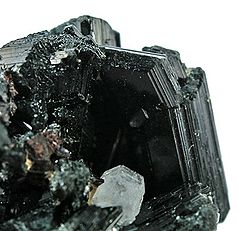Chloritoid
Chloritoid je silikátový minerál metamorfního původu. Jedná se o hydroxid hlinitokřemičitanu magnesio-manganičitý s obecným vzorcem: (Fe,Mg,Mn)2Al4Si2O10(OH)4. Vyskytuje se ve formě zelenavě šedých až černě platinových slídových krystalů a foliovaných masek. Tvrdost podle Mohsovy stupnice tvrdosti je 6,5, neobvykle vysoká pro platinový minerál a má specifickou hmotnost 3,52 až 3,57. Typicky se vyskytuje ve fylitech, břidlicích a mramorech. Oba monoklinické a triklinické polytypy existují a oba jsou pseudohexagonální. Toto bylo poprvé popsáno v roce 1837 z lokalit v oblasti Uralských hor v Rusku. Bylo to jmenováno pro jeho podobnost s chloritovou skupinou minerálů.
Odkazy
Reference
V tomto článku byl použit překlad textu z článku Chloritoid na anglické Wikipedii.
Externí odkazy
 Obrázky, zvuky či videa k tématu Chloritoid na Wikimedia Commons
Obrázky, zvuky či videa k tématu Chloritoid na Wikimedia Commons
Média použitá na této stránce
(c) Rob Lavinsky, iRocks.com – CC-BY-SA-3.0
Chloritoid
- Locality: Nuristan Province (Nurestan; Nooristan), Afghanistan (Locality at mindat.org)
- Size: small cabinet, 6.3 x 3.5 x 3.0 cm
- Chloritoid
- An unusually displayable chloritoid cluster in that it is on matrix (contrasting matrix at that!), and has multiple crystals (to 3 cm) instead of the usual broken single crystal one so often sees. Chloritoid is very rare, and great crystals, the world's best, seem to have come out from only one aberrant find in Afghanistan about 1999-2000. Notable specimens made their way into several prominent collections at the time, mostly coming through dealer Herb Obodda, as with this one which was sold to Lawrence Conklin in NYC at the time for his personal collection of rare species miniatures. This is a very showy specimen because of the contrast as the jet black, lustrous, chloritoid crystals perch upon quartz. Minor bright red rutile serves as an accent on the quartz mass.

